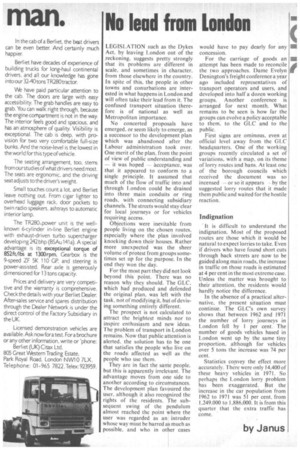No lead from London
Page 29

If you've noticed an error in this article please click here to report it so we can fix it.
LEGISLATION such as the Dykes Act, by leaving London out of the reckoning, suggests pretty strongly that its problems are different in scale, and sometimes in character. from those elsewhere in the country. In spite of this. the people in other towns and conurbations are interested in what happens in London and will often take their lead from it. The confused transport situation therefore is of national as well as Metropolitan importance.
No concerted proposals have emerged. or seem likely to emerge, as a successor to the development plan which was abandoned after the I,abour administration took over. One merit of the plan, from the point of view of public understanding and — it was hoped acceptance. was that it appeared to conform to a single principle. It assumed that much of the flow of traffic into and through London could be drained into three main conduits or ring roads, with connecting subsidiary channels. The streets would stay clear for local journeys or for vehicles requiring access.
Objections were inevitable from people living on the chosen routes, especially where the plan involved knocking down their houses. Rather more unexpected was the sheer volume of protest from groups sometimes set up for the purpose. In the end they won the day.
For the most part they did not look beyond this point. There was no reason why they should. The GLC. which had produced and defended the original plan, was left with the task, not of modifying it, but of devising something entirely different.
The prospect is not calculated to attract the brightest minds nor to inspire enthusiasm and new ideas. The problem of transport in London remains. Now that public attention is alerted, the solution has to be one that satisfies the people who live on the roads'. affected as well as the people who use them.
They are in fact the same people, but this is apparently irrelevant. The advantage moves from one side to another according to circumstances. The development plan favoured the user, although it also recognized the rights of the residents. The subsequent swing of the pendulum almost reached the point where the user was regarded as an intruder whose way must be barred as much as possible. and who in other cases would have to pay dearly for any concession.
For the carriage of goods an attempt has been made to reconcile the two approaches. Dame Evelyn Denington's freight conference a year ago included representatives of transport operators and users, and developed into half a dozen working groups. Another conference is arranged for next month. What remains to be seen is how far the groups can evolve a policy acceptable to them, to the GLC and to the public.
First signs are ominous, even at official level away from the GLC headquarters. One of the working groups recently circulated a set of variations, with a map, on its theme of lorry routes And bans. At least one of the borough councils which received the document was so incensed — or so it appears by the suggested lorry routes that it made them public and waited for the hostile reaction.
Indignation
It is difficult to understand the indignation. Most of the proposed routes are those which it would be natural to expect lorries to take. Even if drivers who have found short cuts through back streets are now to be guided along main roads, the increase in traffic on those roads is estimated at 4 per cent in the most extreme case. Unless the matter was brought to their attention, the residents would hardly notice the difference.
In the absence of a practical alternative, the present situation must continue. The GLC's own survey shows that between 1962 and 1971 the number of lorry journeys in London fell by 1 per cent. The number of goods vehicles based in London went up by the same tiny proportion, although for vehicles over 5 tons the increase was 74 per cent.
Statistics convey the effect more accurately. There were only 14,400 of these heavy vehicles in 1971. So perhaps the London lorry problem has been exaggerated. But the increase in the car population from 1962 to 1971 was 51 per cent, from 1,249.000 to 1.886,000. It is from this quarter that the extra traffic has come.
by Janus












































































































